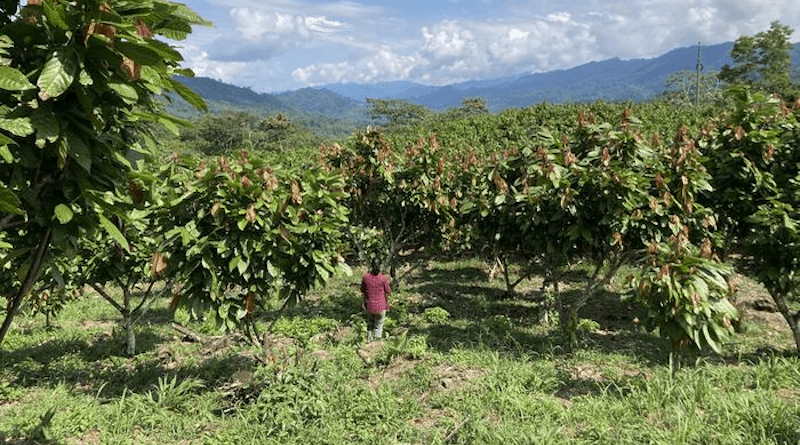Birds And Bats Ensure Yields For Cacao Farmers In Northern Peru
Healthy bat and bird populations don’t only help to keep the endangered tropical dry forests of northern Peru in equilibrium. For the regions’ farmers of cacao—the main ingredient in chocolate— these predators are worth almost $1,000 per hectare of annual production.
In the tropical dry forests of northern Peru, farmers grow some of the most uniquely flavorful cacao in the world. This variety is called Blanco de Piura, named for its succulent white flesh and the region that overlays its biological range, which is very near the site of cacao’s ancient origins. Around the globe, chocolatiers admire this fine flavor cacao, but the locals also sing its praises – including the birds, bats, ants, squirrels, and many other species who are frequent visitors of cacao agroforestry systems.
The conventional model of growing cacao in monocultures favors yield on the short-term, but it’s also fragile, wrought with ecological and economic risks for small farmers. One reason for this is that cacao is an understory plant, but in the conventional model, it’s grown without the shade it relies on in its early development. When cacao is the lone plant in this model, resources are limited for the bugs and other critters that otherwise would be supported and balanced by an entire forest ecosystem.
Cacao agroforestry, distinguished from the conventional methods by the presence of accompanying trees next to cacao, is part of CGIAR’s Nature-Positive Solutions Initiative, or NATURE+. Practitioners of cacao agroforestry plant a variety of trees side by side—some for timber, some for fruit, and some that support wildlife. But the last of these isn’t merely a sacrifice for the sake of biodiversity; NATURE+ researchers at the Alliance of Bioversity International and CIAT have found that farmers actually benefit from working with other creatures that call the forest home.
In northern Peru, irrigated cacao agroforests are fruity oases in an otherwise arid environment. It’d be reasonable to assume that farmers have to compete with the animals and insects that surround them, but the truth is that’s not always the case. Over the past two years, Alliance scientist Carolina Ocampo-Ariza and colleagues documented how birds and bats in the region are some of the farmers’ greatest collaborators. The team’s findings were published in Ecological Applications in May.
Ocampo-Ariza and her team discovered that birds pass their days and bats their nights consuming the aphids and mealybugs that would otherwise harm the tiny white blossoms of cacao trees, as well as young fruits. Of course, fewer blossoms mean less fruit and less cacao to sell. In fact, when Ocampo-Ariza prevented birds and bats from accessing individual cacao trees, she found that those trees received the most damage from pests and had the smallest cacao yields. Cumulatively, Ocampo found that the presence of birds and bats accounted for 54% of the total productivity of cacao trees in her study. Ocampo explains that the birds and bats provide a “pest predation service” without any cost to the farmer or the environment. And the cacao yield that results from this protection? It’s worth approximately $959 per hectare per year for Peruvian cacao farmers in the study site.
Ocampo-Ariza also spent a lot of time looking at ants. During her yearlong experiment, she recorded 4,737 ant visitors, of which 40% were from the genus Nylanderia, a globally spread group known for its friendship with sap-sucking insects that are deleterious to tree crops. (In this mutualism, the aphids and mealybugs produce sap the ants feed on in exchange, presumably, for protection from predators provided by the ants.) But Ocampo-Ariza found that it wasn’t Nylanderia’s sheer abundance that made them harmful to cacao agroforests. As it turns out, Nylanderia were only correlated to reduced cacao yields in study sites that were located far away from native forests. Although Ocampo-Ariza doesn’t yet know the exact reason, she hypothesizes that unidentified native species neutralize the effect of this prolific ant population in cacao agroforestry systems that are located in close proximity to native forests.
In the next phase of research, Ocampo-Ariza plans to look at the species-level interactions between native shade trees, birds, bats, and insects. She wants to know who’s specifically eating whom and what conditions are needed by beneficial animals to remain in agroforestry systems. Ultimately, this is the way agroforestry progresses — with research and applications at the ecosystem and trophic levels.
How research helps producers
The ecosystem services provided by a group of organisms in one area, may be provided by different organisms in another. While birds and bats help with cacao yield in the tropical dry forests of northern Peru, rodents, snakes or another organism may be the main actors in a different region. While guided by the principles of polyculture and preserving native biodiversity, agroforestry in any two regions won’t look the same. To address this complexity, Alliance scientists are developing a web-based tool that compiles decades of research like Ocampo-Ariza’s to generate agroforestry designs that are location-specific and accessible for individual farmers. The tool (available at cacaodiversity.org) will be piloted with communities in Peru this year.
Cacao agroforestry in Peru—and the Alliance scientists that investigate and support them—continue to demonstrate that nature and small farmers can work together for results that benefit local economies and the planet.

